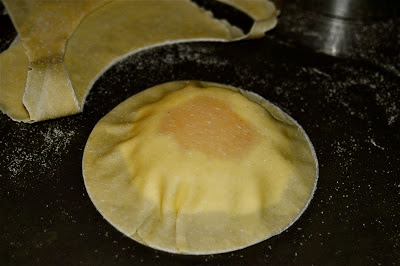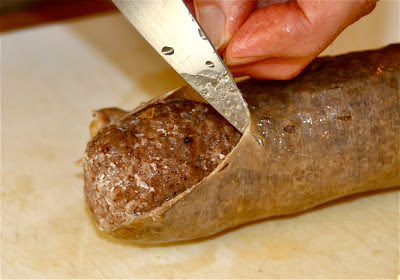Saturday, January 19, 2013
Ravioli al uova (with egg yolks)
This is gonna be fun.
If you like soft egg yolks, that is. And fresh pasta. And cheese, of course.
I sure enjoyed making these ravioli, a specialty of Italy's Emilia-Romagna region if you wondered. And they aren't nearly as difficult to put together as you might think.
No lie.
It helps if you are comfortable working with fresh pasta dough (here's how I make it). These ravioli are large (5 inches around) and so make sure to roll out a wide pasta sheet (say, 8 inches or so). These sheets aren't rolled to the thinnest possible setting, but they are fairly thin (just under the No. 2 setting on my machine.)
The filling? Basically what you have here is a "nest" made out of ricotta and goat cheese (see the filling recipe below). After placing the cheese mixture on the pasta sheet, hollow out a place in the center large enough to accommodate an egg yolk. After the yolk is placed (be careful here, you don't want it to break) make sure that the cheese is higher than the yolk. If it isn't gently add more cheese all around the circle.
Lay another pasta sheet on top. (If the dough is on the dry side use an egg wash first; that'll help the two pasta sheets come together.)
And cut with whatever tool you have around. This 5-inch pastry cutter works great, but even the rim of a wide wine glass can do the trick.
Press down on the edges to make sure they're secure, and they're ready to be boiled.
These ravioli need to be handled gently, and so I put them into the water and take them out with a large slotted spoon. Do not dump them into a colander!
Don't bother doing a complicated sauce because it isn't at all necessary. This is a brown butter sauce, which I managed to ramp up with some black truffles I had around (it was a special occasion). But the brown butter alone would be great too, especially with a little grated cheese once plated. What I do is take the ravioli right out of the boiling water and place them into the pan with the butter, then gently spoon the butter over the ravioli while on medium heat.
Plate it (again, gently).
And there you go.
Like I said, fun. And easy.
Recipe for the filling
Good for six to eight 5-inch ravioli
1 pound fresh ricotta
4 ounces fresh goat cheese
3 tablespoons grated Parmigiano-Reggiano
1/4 teaspoon nutmeg
1/4 teaspoon lemon zest
kosher salt and pepper to taste
Mix all the ingredients together, in no particular order. Taste and adjust to your liking.
Labels:
eggs,
fresh pasta,
Homemade pasta,
pasta,
Ravioli,
vegetarian
Saturday, January 12, 2013
Lemon pasta dough
I don't know what my friends Marla and Jeff imagined might become of these Meyer lemons. A drink perhaps, possibly a delicate Italian baked good. Grown in their backyard in Texas and shipped here for the holidays, the lemons were a very nice surprise. It has been some time since I've been to visit them in Austin and I'd even forgotten that they had the trees.
Some discussions commenced about how best to use the lemons, but the truth is that I knew right away what to lobby for.
Actually, I didn't really lobby at all.
Very early one morning, long before the associate and the house guests stirred, I zested a couple of the lemons.
Then two cups of 00 flour went onto my work surface, along with 2 large eggs, one egg yolk, 1 teaspoon of olive oil, 1/2 teaspoon of salt, 2 tablespoons of the lemon juice, plus the zest.
Still no sound of anybody getting out of bed and my plan was nicely taking hold.
A little more flour and a few minutes of kneading and the dough ball was ready for the fridge.
The next day, at lunchtime coincidentally, I took out the chitarra and got to work on
the meal's main ingredient (once the dough had come to room temp, that is).
The batch of dough made about 3/4 pound of this stuff, enough for a light lunch for four.
Butter, cheese and peas. That's it.
Being an early riser has its benefits.
Sunday, January 6, 2013
How to make cotechino sausage
This is my friend Scott. He likes a good sausage. So does his partner Giovani.
Lucky for me, the two men are particularly fond of cotechino, a highly seasoned Italian variety most often served with lentils to celebrate the New Year. Since I had decided to manufacture my very own cotechino this past holiday, it was easy to put the arm on my very tasteful buds so as to secure at least one additional set of hands to complete the task.
The guy in the picture is the one whose helping hands were offered to me. The other one? He fled to the nearest hot yoga studio for nearly the entire morning that we were scheduled to work (though he did at least have the decency to treat us to a lovely lunch).
Men!
This, by the way, is your traditional presentation of cotechino. It is exactly what I served for New Year's day brunch last week and, according to Italian lore, should bring good luck to me and my guests through the coming year. Finding cotechino is not so easy in the United States, regardless of where you live, and so ask your local Italian specialty store about getting some in or search for it online.
You didn't really think that we'd made enough for everybody, did you?
This is the mixture of ground meat (6 pounds of it) and spices that we used. Cotechino is very different from other sausages; the meat mixture is about 40 percent pork, 30 percent pork fat, and 30 percent pork skin. The skin is very difficult to grind using non-commercial equipment and so Jarrod, butcher par excellence at Rosemont Market here in town, offered to custom grind a mix for us. The seasonings we then used are traditional, if haphazardly measured: 3 minced garlic cloves, 4 tablespoons kosher salt, 3 tablespoons cracked black pepper, 2 teaspoons nutmeg, 2 teaspoons cinnamon, 3 teaspoons cayenne, 2 teaspoons clove, and a scant quarter-teaspoon of pink salt for curing.
Scott was rather insistent that he work with the meat mixture, I don't know why, and it being his place where the sausage-manufactuting commenced I chose not to argue this point.
These being large sausage, roughly a pound each, we opted to make one at a time rather than attempt to link them all together. For a more traditional link sausage-making primer go to this link.
Using pink salt in the mix meant that we could allow the finished sausage to hang in a cool place and cure for 24 hours. My friends' basement was in the 55- to 60-degree range and so that's where the curing took place. With only two cotechino needed for New Year's (one for my friends, another for my guests and I) we froze the other four. (Yes, Fred, you may have one of them. But you'll need to get in the car and drive north.)
Fresh cotechino that has curing salt should soak in cool water before cooking; this helps to remove the salt. New Year's Day brunch was scheduled for around oneish and so I started soaking our sausage around 7 a.m., occasionally changing the water.
Cotechino is boiled at low- to moderate heat, and for varying degres of time, depending on the product you have. This one would take around 90 minutes, Jarrod the Wonder Butcher reasoned, and so at around 11 a.m. the sausage went into a pot of plain water.
At around noon I got the lentil prep going. First I sauteed 2 garlic cloves, 2 finely diced carrots, a celery stalk, a large onion and a hot pepper in olive oil until softened.
Then came a quart of chicken stock, a bay leaf and lentils. (The night before I'd soaked 1 1/4 cups of Italian lentils, which turned into 4 cups after soaking overnight. Of that I used three cups in this recipe.)
When the sausage and lentils were pretty much done I added the cotechino to the pan so that everything could simmer together at low heat for around 15 minutes.
Some people pierce the sausage casing during cooking, but I don't. That means there is liquified fat inside the cooked sausage, which you can either add to the lentils or discard, which is what I did.
All that's left to do now is remove the sausage from the casing, slice, and arrange over the lentils in a serving dish.
If this doesn't bring you good luck I really do not know what will.
Happy New Year everybody!
Labels:
cotechino,
Homemade sausage,
new year's,
sausage
Thursday, January 3, 2013
The four days of gluttony
Every year my friends Tom and Beth spend four or five days here in Maine to celebrate the new year. It is a nonstop food-and-drinkfest, of course, and it's rare that a meal isn't memorable or, at the least, photographed. Judging from some of the reactions to the foods we ate this year (check the Facebook page) I thought a recap might be enjoyable, and so here goes. (Note: this isn't everything we consumed, but you get the idea.)
The dish above is just something I threw together for the night my friends arrived. It's a long bus trip from New York and so a simple meal and an early bedtime usually is how things go the first night. The pappardelle are homemade and handcut; the sauce is an oxtail ragu that I'd frozen and saved because I knew Tom and Beth would like it.
Roasted veal breast served over polenta, courtesy of my associate.
One of the best seafood chowders you're apt to run across, also from my associate's hand.
As were these sauteed (in olive oil and butter) jumbo shrimp.
The whole suckling pig that we roasted in the wood oven was the highlight of the visit, for sure. However, as many find the sight upsetting, here is a detail of one of the pieces that landed on my plate.
Beth and Tom collaborated on an awesome pumpkin pie. There are crumbled bacon bits in the crust and a slice of candied bacon served along with the whipped cream.
My friend Ish dropped by one night with a mess of whole sardines, and proceeded to toss them into the wood oven.
The standout on New Year's Eve was this tourtiere, a combined effort by Beth and my associate. I'm speechless.
The last of the great Bordeaux that were hangin' in my cellar. Sorry to see them go but a real nice match with the meat pie.
As promised, Tom unwrapped a 3-year-old fruit cake. The boy makes a fine one, for sure.
New Year's brunch was homemade cotechino over lentls. (I'm working on a separate post about this which should be up on the blog in a few days.)
That night, the last of this year's visit, called for a super simple meal, and so homemade tortellini en brodo did the trick.
See you next year. I hope.
Labels:
Beth,
new year's,
Tom
Subscribe to:
Posts (Atom)












































